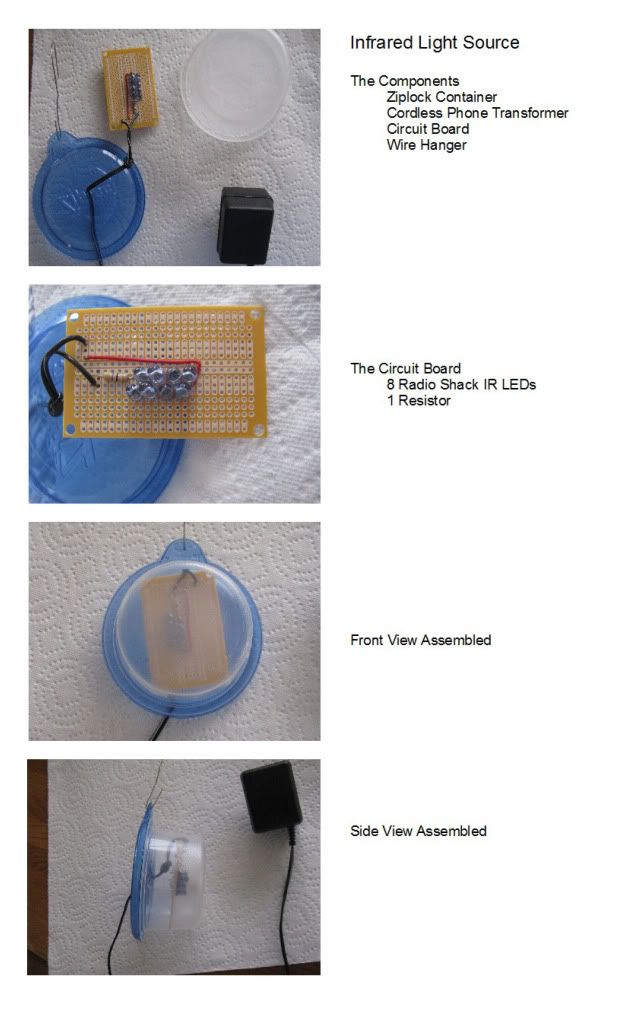My current IR source is a clear, 60-watt incandescent bulb plugged into a dimmer that fits in a standard light socket. I bought the bulb (87701, $2.98) and dimmer (363003 Utilitech Rotary Lamp Dim, $5.98) from Lowe's. The lamp (with shade removed) is just a lamp I've had forever. My guess is this will work with an ordinary clamp light if I ever decide I want to put a normal bulb back in my old lamp (of course, I also have the option of just turning the dimmer up and putting the shade back on!). If anybody has another IR solution for less than $10 that works out of the box, please post it.
I've also read that heat lamps work, but that they get hot. Wal-Mart sells Critter Culture: Night Heat Bulb 75 Watt for around $6. Perhaps that would work also. Eventually I may acquire an IR LED source of some sort, but I'm happy with my solution for now.
I turn the dimmer up until the filament starts to glow in the visible spectrum. I'd say the light output is about the same as a candle flame, maybe less. I have to turn it up a little higher than it needs to be to get a good result with my (modified) webcam because when the AC kicks on, there's a momentary drop in voltage or current that will cause the light to go out if the dimmer is set lower. I like sleeping with no lights on at all, but when I close my eyes I can't tell that the light is on because it is just not that bright.
My webcam is a cheap webcam I bought off of Amazon ("6 LED USB Digital Web Camera Webcam + Microphone For Laptop Notebook PC for Live Chat Video", $4.99) from a seller called E2E because they use Amazon for fulfillment (i.e. 2-day free shipping for Amazon Prime customers). I was hoping that one of the ways they made it so cheap was to make it without an IR filter, but that wasn't the case. I have a set of precision screwdrivers I used to remove the tiny screws holding the camera together, but maybe screwdrivers from an eyeglass repair kit would work, too. I wound up using the screwdriver to crush the small, square piece of glass with the filter on it from around its edges and removing the pieces from its plastic housing. You do need to remove the filter somehow because it blocks too much of the IR otherwise. I didn't bother replacing the filter with exposed film or whatever and it works fine for me.
The pictures I get from this webcam are not HD quality. It's a cheap webcam. But they're good enough that I can see how I move around at night while I sleep, which is what I care about. The video stream from the camera gets choppy if there is a lot of movement, but I am not using this feature. I use the webcam to take pictures every second and then stitch those pictures together into a time lapse video. To capture the pictures, I use Ubuntu 12 (Linux) and a version of the GNOME Cheese application that I modified so that it would handle the tens of thousands of pictures (the standard version has a "burst" mode, which is cool, but it crashes after it captures a few thousand pictures). To stitch the pictures together into a video (15 fps), I used mencoder and its -mf option, in a variant of a command I found in a blog post at
http://derwiki.tumblr.com/post/45597574 ... tu-box-and (note that gphoto2 is meant to work with image files from digital cameras, not streams from webcams). For Windows, one might be able to use Debut Video Capture Software, which is supposed to have a free version for home use. I used it to do a quick test of my webcam when I first got it. There is no audio because I am doing time-lapse photography.
So not counting my computer, or my old lamp, or the screwdrivers, or the Amazon Prime membership, my setup cost me $2.98 + $5.98 + $4.99 = $13.95.

